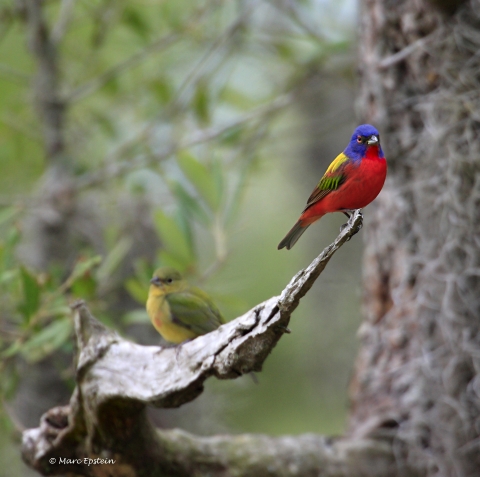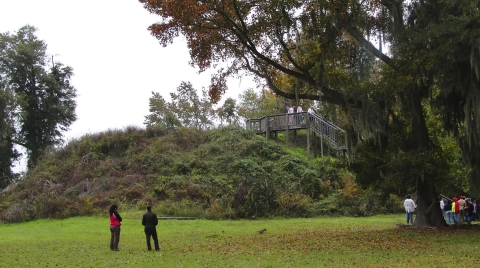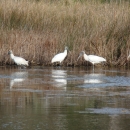About Us
Santee National Wildlife Refuge, encompassing 15,000 acres, was established in 1942 and is located in the upper Atlantic Coastal Plain region of South Carolina. The refuge is superimposed on the lands and waters of the 110,600-acre Lake Marion reservoir in Clarendon County. The South Carolina Public Service Authority, a.k.a. Santee Cooper, created Lake Marion as a hydroelectric project on the Santee River. Santee NWR benefits migratory waterfowl, neo-tropical songbirds and other birds, and terrestrial and aquatic wildlife in this ecosystem. The refuge contains a wide diversity of habitats including mixed hardwoods, mixed pine hardwoods, pine plantations, marsh, croplands, old fields, ponds, impoundments, and open water.
A myriad of wildlife species inhabit the diverse landscape of Santee NWR. From November through February migrating waterfowl such as ring-necked duck, pintail, teal, and wood ducks, along with Canada geese, are a major attraction. Throughout the year, red-tailed and red-shouldered hawks can be viewed as can a variety of songbirds, wild turkey and wading birds. The forests are home to white-tail deer, squirrels, bobcat and other woodland creatures. Alligators, turtles, fish, insects and other wildlife are found in ponds and marshes.
Santee NWR also contains areas of cultural and local significance. The 420-acre Dingle Pond Unit consists primarily of a Carolina Bay and is a designated public use natural area. A historic site on the refuge is the Santee Indian Mound-Fort Watson area. The mound is over 1200 years old, dated as built sometime between 1200 and 1400 A.D. During the Revolutionary War, a garrison of 100 British soldiers were at the mound, giving strategic control over the Santee River and a road connecting Charleston to Camden. The fort was later captured by American forces under General Francis Marion.
Santee NWR has several special designations that include an Audubon Important Bird Area, a Refuge Waterfowl Sanctuary and, the Santee Indian Mound-Fort Watson listing on the National Register of Historic Places.
Santee Indian Mound - Fort Watson
The large hill located on Lake Marion adjacent to the Santee National Wildlife Refuge is known as the Santee Indian Mound. The Santee Indians were part of the Mississippian culture that lived in this area for thousands of years. The mound itself is approximately 1200 years old. The mound served as a prehistoric ceremonial center of a native culture that flourished on the coastal plain in the centuries before the founding of Charleston. The site here at Scotts Lake is the largest such ceremonial center discovered on the coastal plain to date. It appears that the mound, besides being the site of various religious rites, was also used for burials. Archaeologists have excavated at least sixteen graves, each containing artifacts.
Although the British excavations during the later fortification of the mound destroyed much archaeological evidence, it appears that there may have been native American structures on the summit. Subsurface remains indicate walls that were built using posts set in the ground and woven with saplings, then plastered with a mud mixture known as “daub”. These structures consisted of four main poles used to form a circular hut. By the beginning of the American Revolution, the site had been abandoned by the Indians. The site, however, took on a new and more violent role during this period.
Perhaps, the Santee Indian Mound’s greatest notoriety comes from its use as a British fort during the American Revolution. This outpost, named Fort Watson, was part of a chain of British strong points that stretched across South Carolina and included Fort Mott, Granby, Ninety Six, Camden and Charleston. The site was the ideal location for a fort as it provided an elevated vantage point that overlooked the Santee River and the road to Charleston. The mound was incorporated into a stockade built by Colonel John Watson and his troops. Contemporary descriptions and archaeological evidence point to a stockade of vertical logs around the summit. To make it more difficult to move up the face of the mound, ditches were cut and three rows of pointed stakes were constructed on the slope.
On February 28, 1781, General Thomas Sumter’s partisans attempted to take the post by storm. The British had a great advantage with two cannons and the Americans were forced to abandon the attack. A second attempt in April began as a siege. The new campaign was under the direction of Francis Marion and Lt. Colonel Henry “Light Horse Harry” Lee and his Continental troops. The British did not have the advantage as in February, as the two cannons had been moved to another area. The fort was under the command of Lt. James McKay of the British Army.
The stalemate might have gone on for some time had it not been for the ingenuity of Major Hezekiah Maham of Francis Marion’s legion. He proposed to build a tower to be used to fire into the stockade and thus neutralize the advantage of elevation that the British had. The tower was built out of rifle range of the fort, and then moved into place possibly on wheels or a wagon frame.
Lt. McKay described the day, “They likewise in the afternoon brought down a wooden machine that they had built, and were busy in raising a scaffold made of rails and mold, nearly level with the top of our works for their marksmen to pick off our sentinels”.
The tower made it possible to cover much of the fort with rifle fire. The Americans, under cover of fire from the tower, pushed their trenches forward until they were able to begin undermining the surrender of Fort Watson. Following the British surrender, Francis Marion demolished the fort to give the British no opportunity to regarrison it. The action at Fort Watson lasted only eight days and casualties were light on both sides. However, the fall of Fort Watson was an important link in the chain of events that made the British authorities abandon the back country of South Carolina.
History of Santee Indian Mound and Fort Watson is provided by Refuge staff in cooperation with the Santee Indians and the Clarendon County Archives.
Our Mission
Each unit of the National Wildlife Refuge System is established to serve a statutory purpose that targets the conservation of native species dependent on its lands and waters. All activities on those acres are reviewed for compatibility with this statutory purpose.
The lands and waters of Santee NWR provide numerous migratory bird benefits and many recreational opportunities. The refuge was administratively designated under the Migratory Bird Conservation Act and the Refuge Recreation Act, therefore outlining the primary purposes of Santee NWR:
“…for use as an inviolate sanctuary, or for any other management purpose, for migratory birds.” 16 U.S.C. 715d (Migratory Bird Conservation Act)
“… to conserve and protect migratory birds … and other species of wildlife that are listed … as endangered species or threatened species and to restore or develop adequate wildlife habitat.” 16 U.S.C. 715i (Migratory Bird Conservation Act)
“… suitable for (1) incidental fish and wildlife-oriented recreational development, (2) the protection of natural resources, (3) the conservation of endangered species or threatened species …” 16 U.S.C. 460k-1” … the Secretary … may accept or use … real … property. Such acceptance may be accomplished under the terms and conditions of restrictive covenants imposed by donors …” 16 U.S.C. 460k-2 (Refuge Recreation Act (16 U.S.C. 460k-460k-4), as amended).
Our History
1200-1400 AD Santee Indian Mound
1781, April 15 British surrender Ft. Watson to Francis Marion
1939-1942 Lake Marion created
1942, May 5 Santee National Wildlife Designation
1969 National Register of Historic Places designation (Santee Indian Mound)
1975 50 year lease effective between US Fish and Wildlife Service and South Carolina Public Service Authority
1975 Wilderness Designation Proposal (not acted on)
1981 Santee NWR Visitor Center opens
Other Facilities in this Complex
Encompassing over 115,000 acres, South Carolina Lowcountry Refuges Complex is home to four national wildlife refuges located in the coastal area known as the Lowcountry, the low lands extending from the Atlantic Ocean to the western sandhills. These public lands comprise some of the most unique and biologically diverse wetland and upland ecosystems along the Atlantic Coast. Within these landscapes are found one of only 20 Western Hemisphere Shorebird Reserve Network sites in North and South America, one of the largest undeveloped estuarine wetland systems remaining along the U.S. Atlantic coast, a critically endangered longleaf pine forest ecosystem and, the only known maritime sandhill community in the state.








